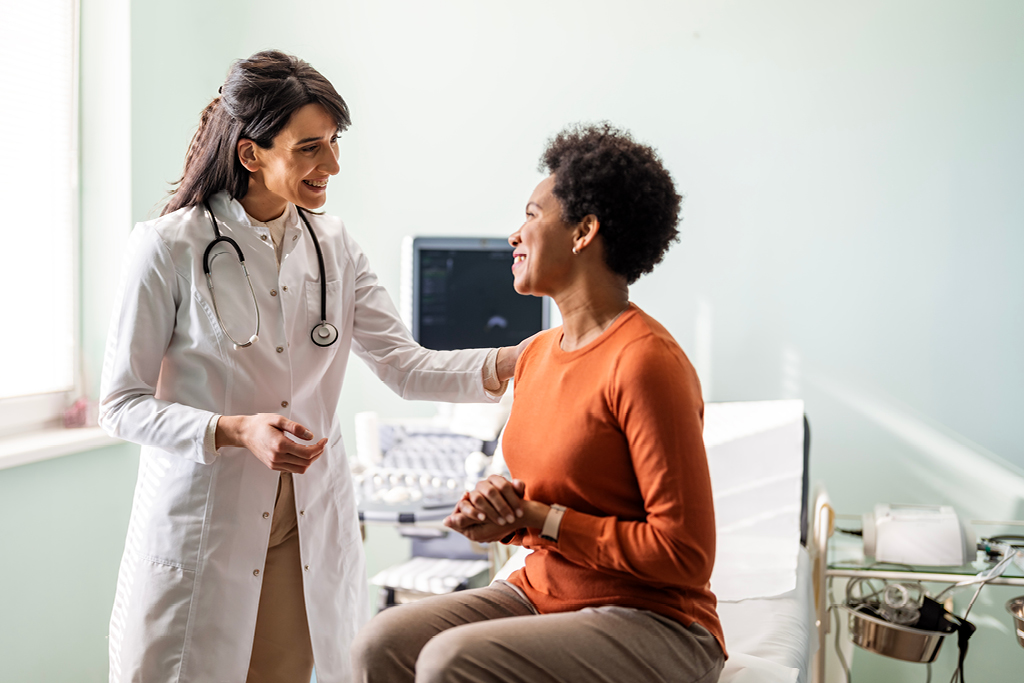Ovarian cysts are common, fluid-filled sacs that develop on or inside an ovary. There is more than one type of ovarian cyst, and there are different causes for them. Treatment varies for ovarian cysts, which can be a half-inch to 4 inches, but sometimes larger, and they are usually painless.
They are most common in women of childbearing age. With regular pelvic exams, your provider can diagnose changes in your ovaries as early as possible. Watch for changes in your menstruation that span several cycles, and discuss concerns with your provider.
What are the common causes of ovarian cysts?
Most are called functional cysts because they indicate the ovaries are functioning normally. Sometimes called simple cysts, they aren’t disease-related, but they grow in response to your body’s changes during your menstrual cycle.
The two most common types are:
FOLLICULAR CYST
Ovaries grow small cysts called follicles monthly. Follicles make the hormones estrogen and progesterone and they split up to release an egg during ovulation halfway through a cycle. The egg travels down a fallopian tube. If the follicle fails to burst, it causes a follicular cyst.
CORPUS LUTEUM CYST
The process of conception depends on the presence of estrogen and progesterone. The follicle, after producing these hormones, is known as the corpus luteum. A cyst forms if the follicle opening gets blocked and fluid builds up inside the corpus luteum.
Not all ovarian cysts form in response to your menstrual cycle, but your doctor might want to follow up on them to prevent complications. Other types are much less common and include:
CYSTADENOMA
It grows from ovarian surface cells, sometimes filled with mucous. It can grow very large.
DERMOID
Also called a teratoma, it grows from ovarian cells and eggs and can contain tissue such as:
- Bone
- Fat
- Hair
- Skin
- Teeth
ENDOMETRIOMA
They’re blood- and tissue-filled cysts similar in appearance to the uterus lining. They’re also called chocolate cysts because they’re dark in color. They happen in women with endometriosis, a disease in which the uterus lining grows outside the uterus.
How do you get ovarian cysts?
Ovarian cysts are common in childbearing women. Causes include:
- Abnormal cell production
- Cancer, in rare cases (less than 1% of ovarian cysts are cancerous)
- Non-cancerous growths
- Polycystic ovary syndrome (PCOS), a condition that causes many ovarian cysts
- Pregnancy
- Severe pelvic infections such as chlamydia. It’s also known as an abscess
- Using fertility medicines such as clomiphene
What are the symptoms of ovarian cysts?
Many women have no symptoms. Those who do experience dull or sharp pain or pressure in the lower abdomen on the side where the cyst grows. Pain might come and go, but a ruptured cyst might cause sharp, sudden pain.
Other symptoms include:
- Abnormal vaginal bleeding, in rare cases
- Breast tenderness
- Difficulty emptying your bladder completely
- Lower-back or thigh pain
- Pain during sex
- Late or painful menstruation
- Weight gain
When are ovarian cysts of concern?
When one ruptures, symptoms might not occur. But a ruptured cyst can also cause blood and fluid loss, leading to low blood pressure. At this point, the patient might need surgery.
Your doctor should follow up on cysts that cause symptoms or grow. Track your symptoms and report them to your provider.
It’s rare, but ovarian cysts can also cause fallopian tube torsion. Seek immediate medical attention if you have:
- Sudden, severe abdominal or pelvic pain
- Pain with fever or vomiting
- Signs of shock, including:
- Cold, clammy skin
- Lightheadedness
- Rapid breathing
- Weakness
How are ovarian cysts diagnosed?
Health care professionals can diagnose cysts. These physicians include:
- Certified nurse midwife
- Obstetrics and Gynecology doctor (OBGYN).
- Primary care provider
Your provider will ask about your health history and symptoms and conduct an exam. This likely will include a pelvic exam to check for ovarian swelling, usually the first sign of a cyst in women without symptoms.
If your provider suspects a cyst, he or she will likely order further tests to determine the type. Tests can also rule out other issues, such as ectopic pregnancy, which occurs when a fertilized egg grows outside the uterus.
Tests might include:
BLOOD TESTS
These look for cancer, hormone issues, and whether the cyst bleeds.
LAPAROSCOPY
In this operation, a physician examines the ovaries and the pelvic cavity with a tiny camera. Cysts can be removed during this procedure if necessary.
MRI
A computer and magnets create a detailed image of the cyst.
ULTRASOUND
A test that uses sound waves to see the cyst’s location, shape, and size, and if it is solid or liquid-filled.
How can ovarian cysts be treated?
Treatment depends on the type of cyst, and the patient:
- Age — they usually develop before menopause
- General health
- History of ovarian cysts
Most women don’t need treatment but should watch for symptoms. Ovarian cysts usually disappear without treatment in a few weeks or months.
A provider might suggest surgery if blood tests or ultrasound detect cancer, to remove part of or the entire ovary. Women with endometriosis might want the cyst removed to help with fertility.
Surgery might be the most effective option also if the cyst:
- Appears to be growing
- Causes pain or pressure
- Is very large
A provider might suggest that patients with hormone problems take birth control pills to help prevent ovarian cysts. Work with your provider on a treatment plan that works for you. Keep follow-up appointments.
Tell your doctor about any sudden pain or other serious symptoms that could mean a ruptured cyst. Cysts can cause weight gain as a result of bloating, and some cysts secrete hormones that cause weight gain.
Visit the Wilmington Health OB/GYN department to learn more
Wilmington Health provides TRUE Care to women from puberty through adulthood. Our board-certified obstetricians and gynecologists focus on compassionate care in our community. Come see the difference in the highest standards of medical care.
Schedule an appointment with one of our qualified OB/GYN providers today.

